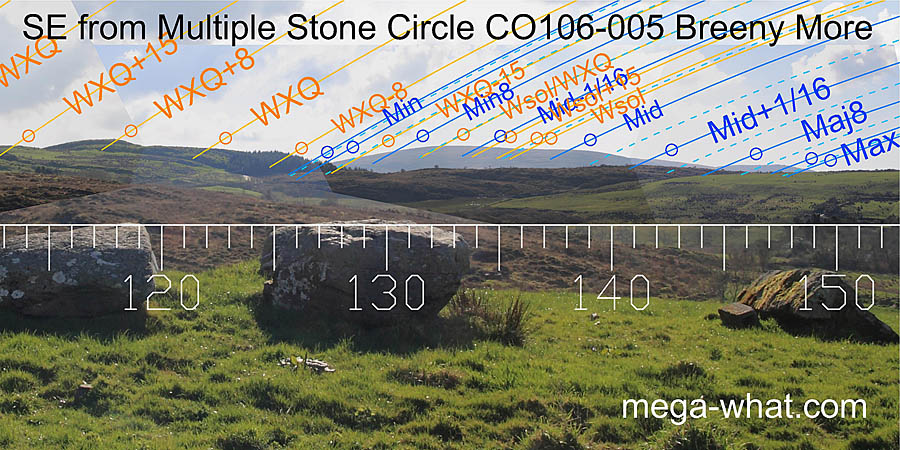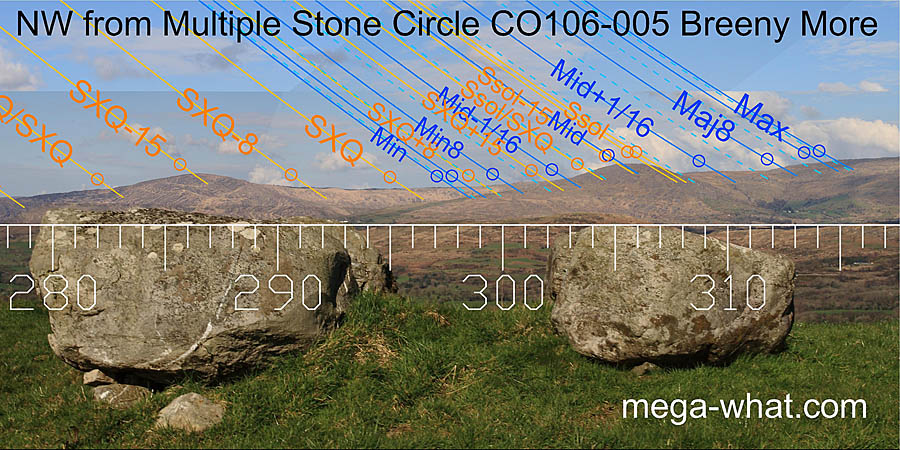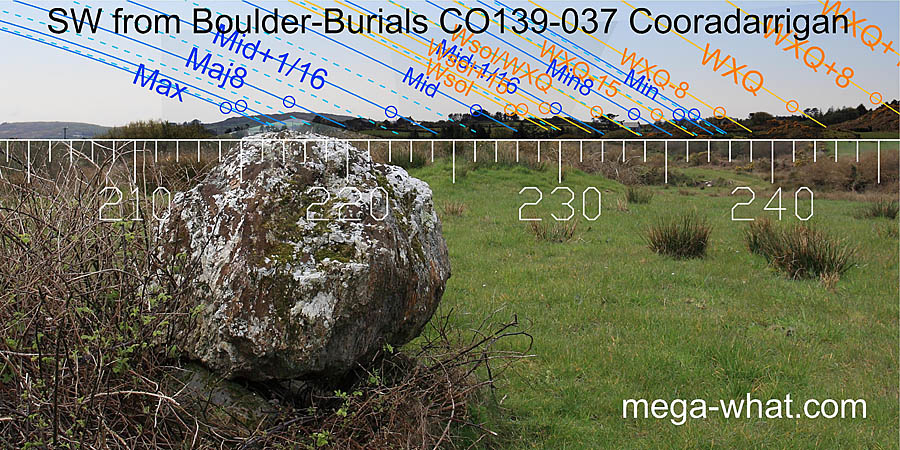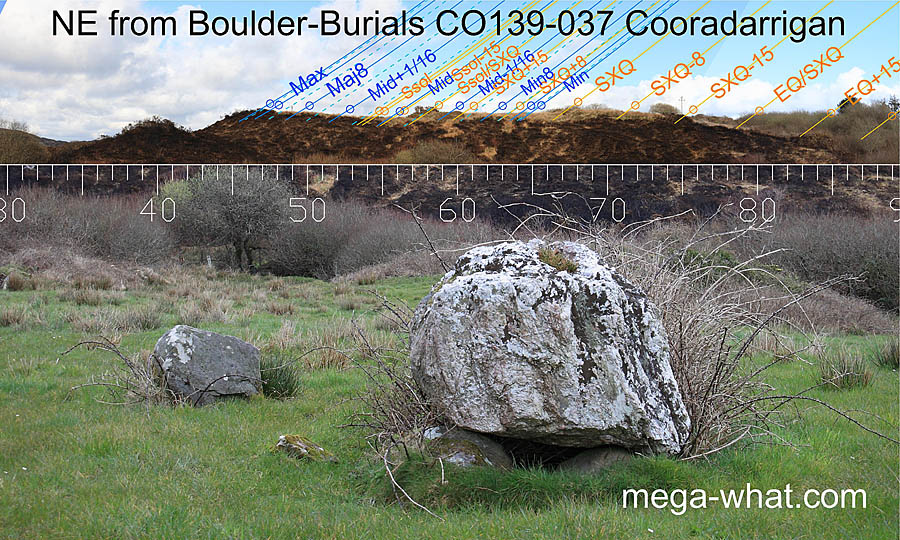Axial alignments at 18 surveyed Boulder-Burial sites.
Sorted by: Location Name | Alignment Class
Boulder-Burials are bronze age megalithic monuments associated with the Cork-Kerry Stone Circle Complex in Ireland and not found elsewhere.
Sometimes there is more than one at a site and if so they are usually close together.
- For classification purposes these surveyed horizons have been divided into a small number of zones.
This classification is an overall one that considers all axes to be potentially bi-directional.
- Extreme is where sun and moon never rise or set but excludes the north-south axis of celestial rotation.
- Lunar is where lunistices
Lunistices are the most northerly and southerly moons of the month. The lunar equivalent of solstices. More.
occur but sun rises or sets do not.
- Solar is where sun rises or sets occur but lunistices do not.
- Solar / Lunar is where a lunistice zone overlaps with the outer regions of the sun's annual travels.
Alternatively one direction may be purely solar while the other is somewhere within a lunistice range.
- Note that these terms may well have other uses elsewhere.
Axial Alignment Classes of surveyed boulder-burials
| Type | Number | %
|
|---|
| Solar | 3 | 17
|
| Solar / Lunar | 6 | 33
|
| Lunar | 5 | 28
|
| Extreme | 4 | 22
|
| North-South | - | -
|
| All | 18 | 100
|
- Boulder-burials appear to be the only monument type in the Cork-Kerry Stone Circle Complex that do not always have a north-east / south-west axial orientation.
- The ones with extreme axes seem to either bisect the space between a standstill and north-south or indicate the east & west horizons perpendicular to the long axis.
- This is not a representative sample, just the most obviously linear ones.
Of this sample (excluding the four with extreme axes), five are uni-directional and nine are bi-directional.
See for yourself:
- Orange Solar trajectories split the tropical year into 48 "Tweeks" (7.6 day mean) that are better regarded as quarter-months.
- Solid Blue Lunar lines split cyclical lunistice position variation into 16 periods of about 14 months each.
- Lunistices are the most northerly and southerly moons of the month [More].
- Also see Technical Notes on the Pictures
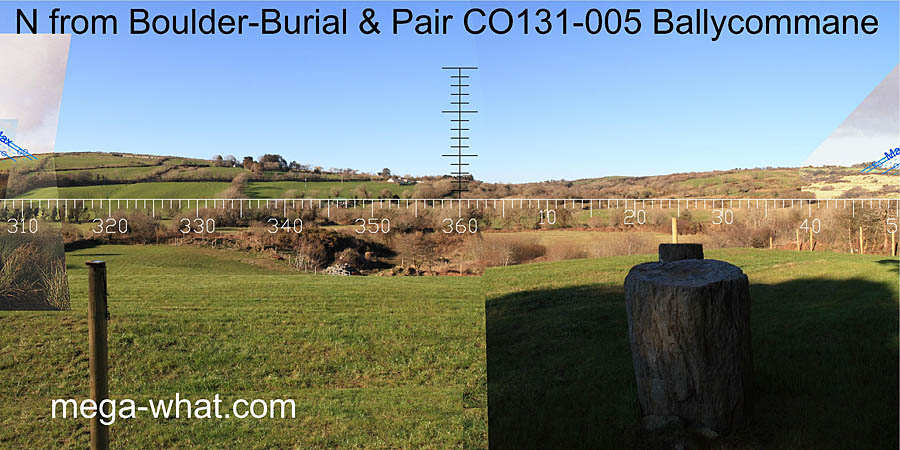
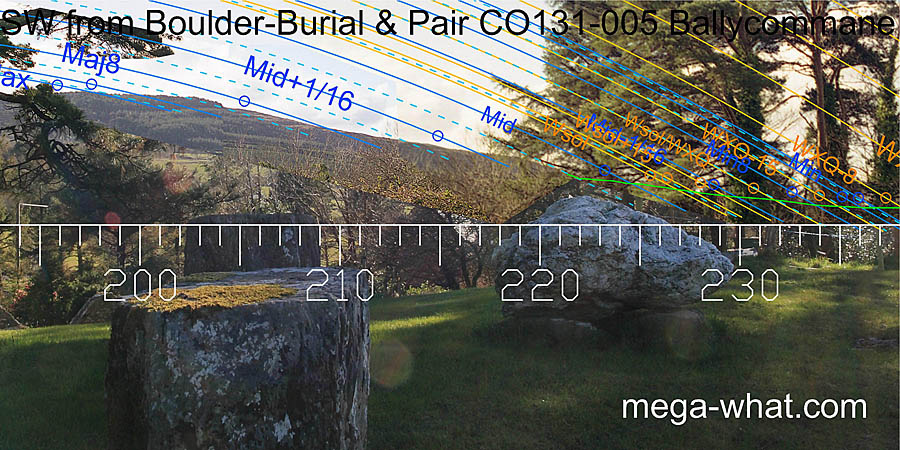 Ballycommane Stone Pair (& Boulder-Burial)
Ballycommane Stone Pair (& Boulder-Burial):
The axis of this stone pair roughly bisects the space between north and north-eastern major standstill. To the south-west, lunar major eighth is indicated.
The boulder-burial is harder to interpret but may well indicate lunar mid cycle to the south-west while being slightly beyond major standstill to the north-east.

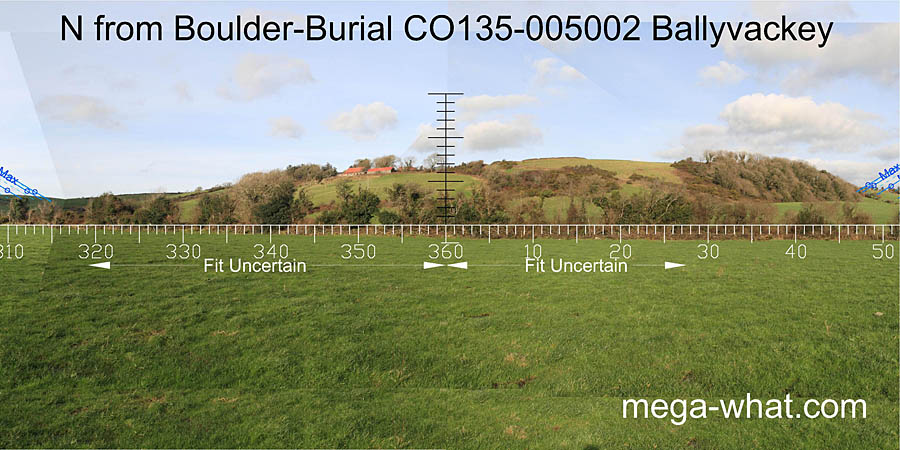 Ballyvackey Boulder-Burial
Ballyvackey Boulder-Burial:
Listed as a possible boulder-burial this one has a small standing stone at its northern end.
The long axis roughly bisects the space between south-eastern major standstill and south. Similarly to the north-west.

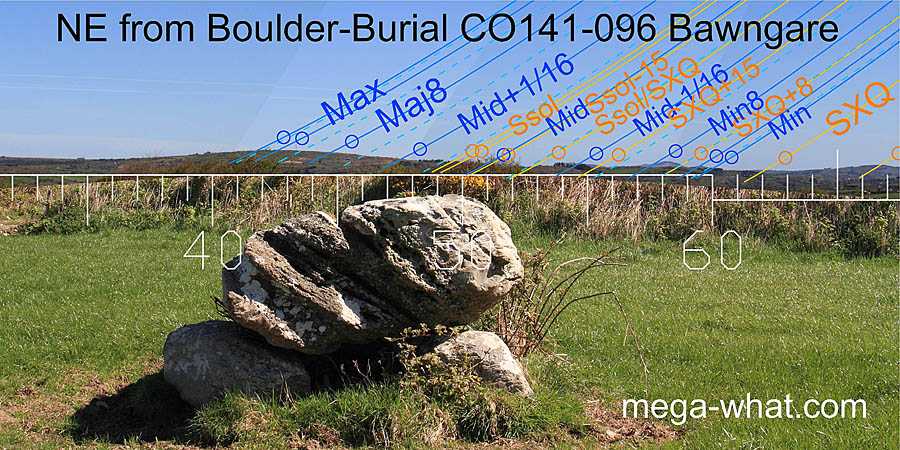 Bawngare Boulder-Burial
Bawngare Boulder-Burial:
The primary axis is to the south-west where it covers the minor half of the lunistice range. To the north-east it covers the major half.
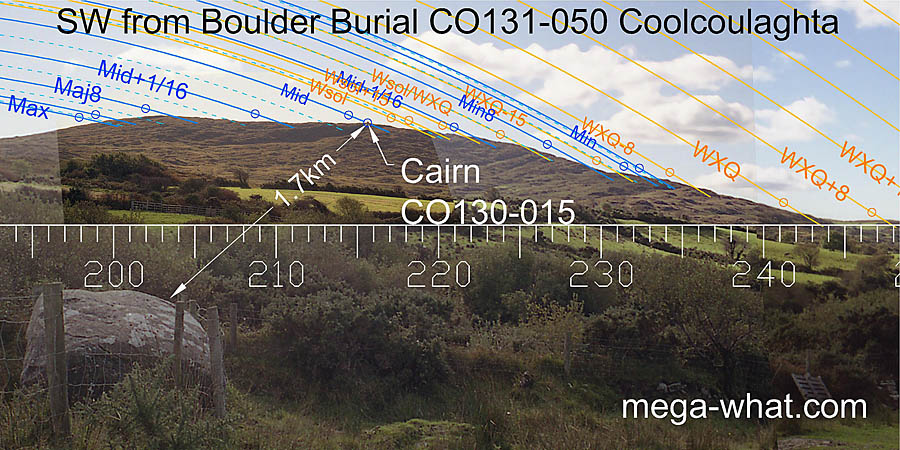
 Coolcoulaghta Boulder-Burial
Coolcoulaghta Boulder-Burial:
The axis of this rectilinear boulder is towards the south-west and the major standstill.
It is well beyond that to the north-east and the ground falls sharply away so that looking over it is not possible.

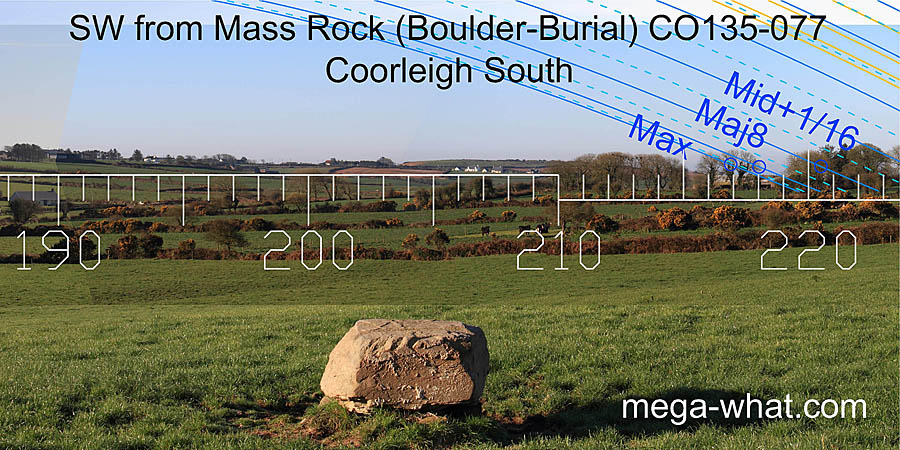 Coorleigh South Boulder-Burial / Mass Rock
Coorleigh South Boulder-Burial / Mass Rock:
The flat top is decorated with two prominent transverse grooves delimiting a central area containing perhaps thirteen cupmarks
[Pic].
The north-east axis roughly bisects the space between north and north-eastern major standstill. The south-western one is somewhat similar but slightly closer to the standstill.
The carved grooves however would seem to indicate the half-month before Samhain (to the SE) and the half-month before Lughnasadh (to the NW).

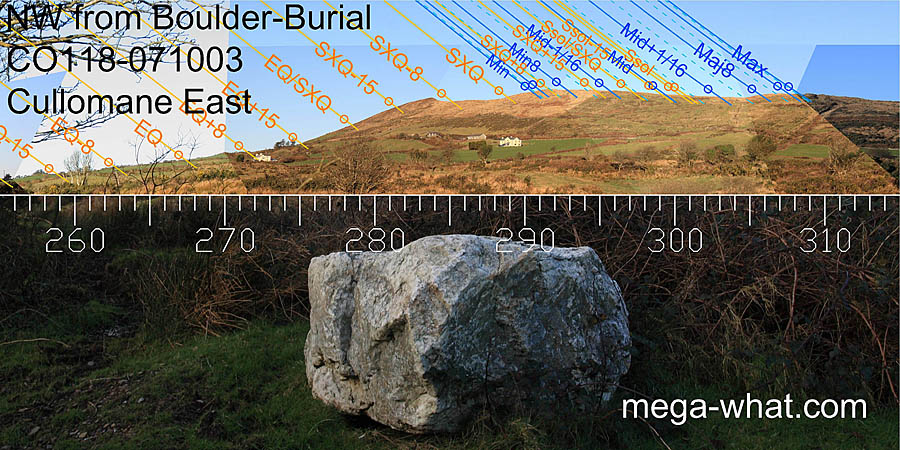 Cullomane Boulder-Burial
Cullomane Boulder-Burial:
The line from a small outlier, through the boulder to a hilltop cairn marks major standstill but
the diamond-shaped boulder indicates the south-east which is obscured.
Axial reverse indicates summer cross-quarter sunsets but the axis would be half-way between the equinox and winter cross-quarters.

 Currakeal Boulder-Burial
Currakeal Boulder-Burial:
The boulder axis indicates major standstill to the south-west at the position of Currakeal stone row.
The reverse is not really a pointer and well beyond major standstill in any case.

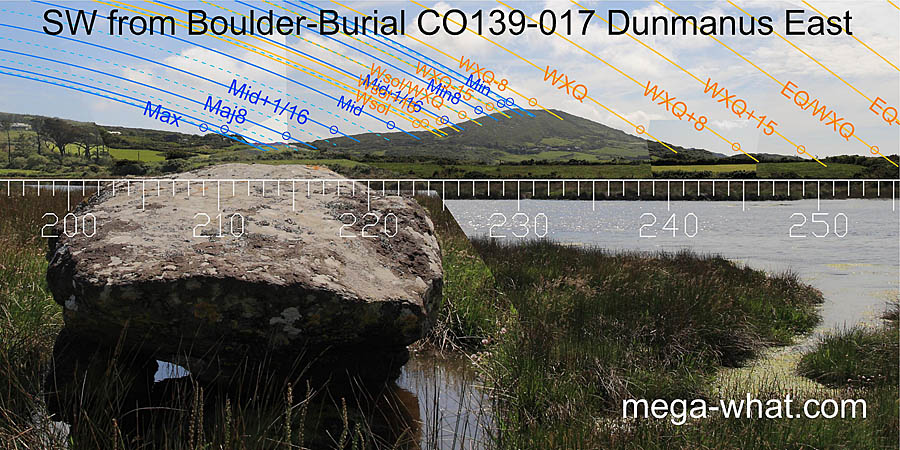 Dunmanus Boulder-Burial
Dunmanus Boulder-Burial:
The axis clearly indicates the south-west and lunar major standstill.
The reverse points beyond the north-eastern lunistice range but the standstill is above the right side of the capstone.
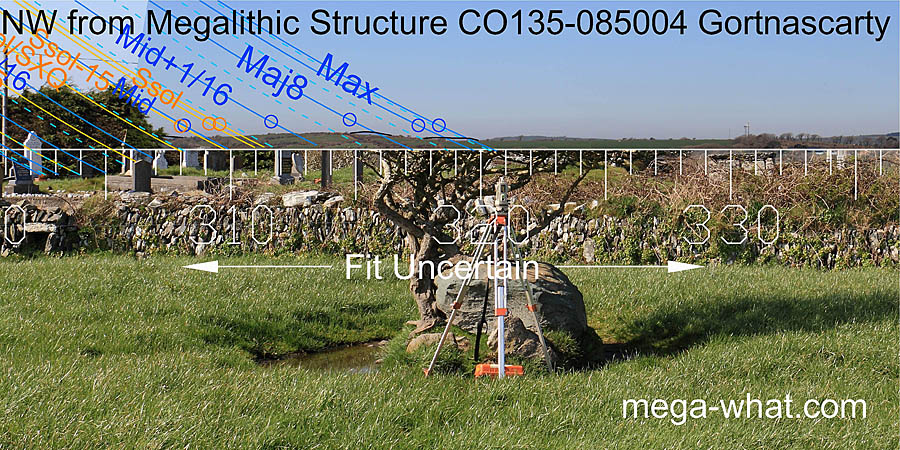
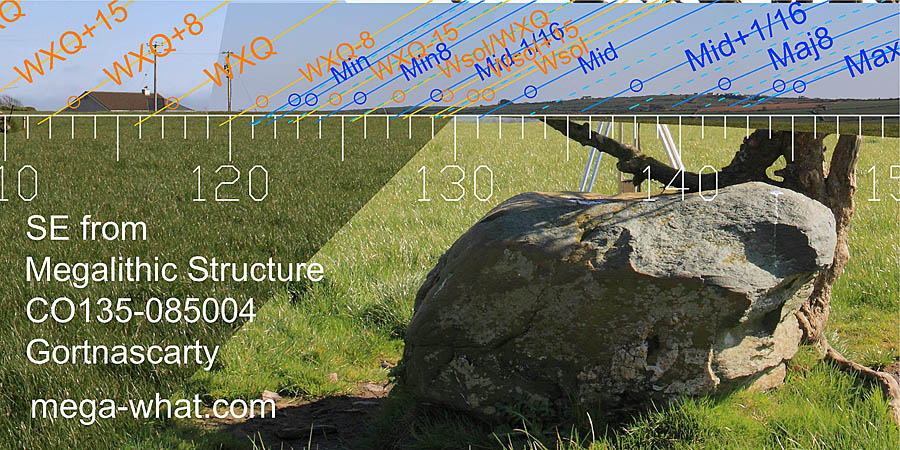 Gortnascarty Megalithic Structure
Gortnascarty Megalithic Structure:
The long axis indicates major standstill to the north-west.
To the south-east it has a broader scope, pointing at the centre of the major half of the lunistice range.

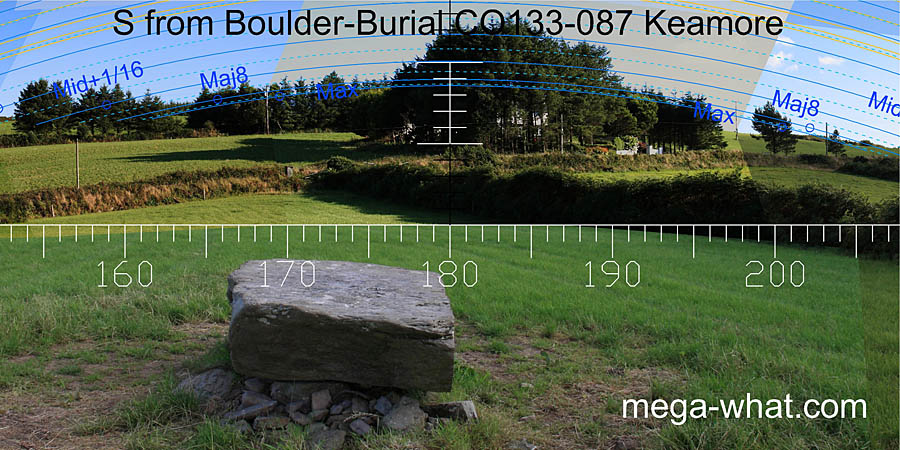 Keamore Boulder-Burial
Keamore Boulder-Burial:
The axis is about 10° anti-clockwise from north-south which
roughly bisects the space between south-east major standstill and due south.
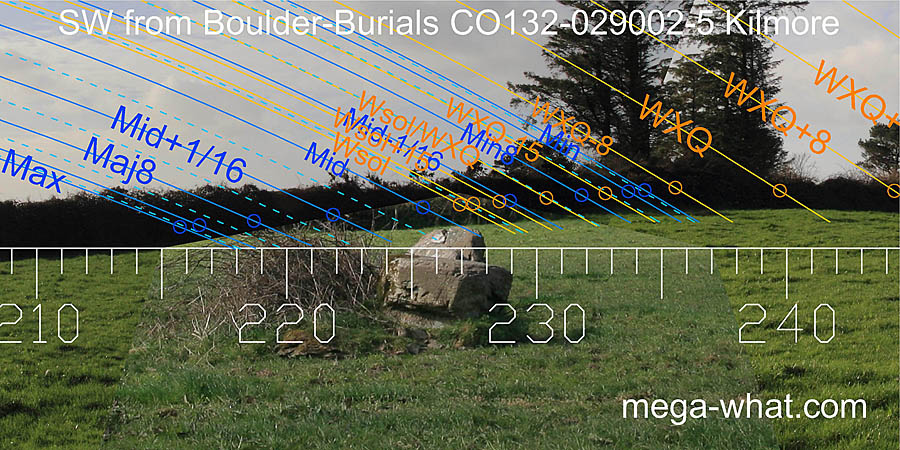
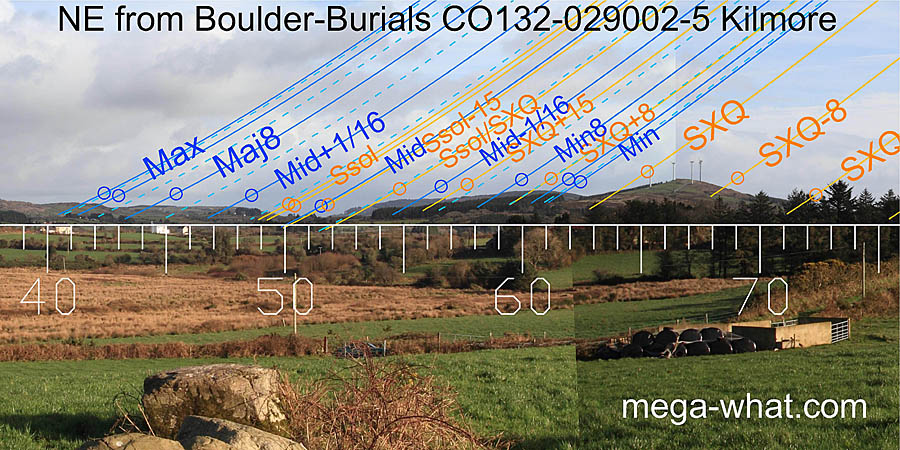 Kilmore Boulder-Burials
Kilmore Boulder-Burials:
This row of four boulders indicates winter solstice or lunar mid-cycle to the south-west. It is possible that standing on them once made a more distant view possible but it is now obscured.
To the north-east, the line is slightly beyond the solstice, towards a lunar sixteenth.
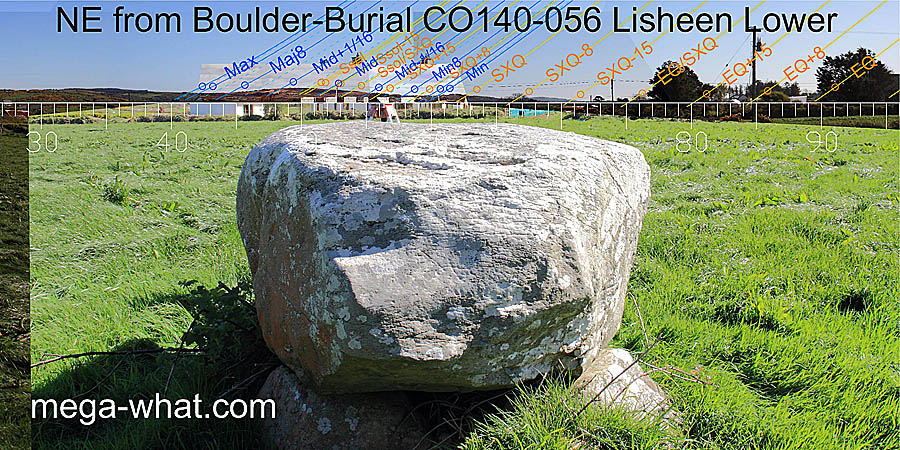
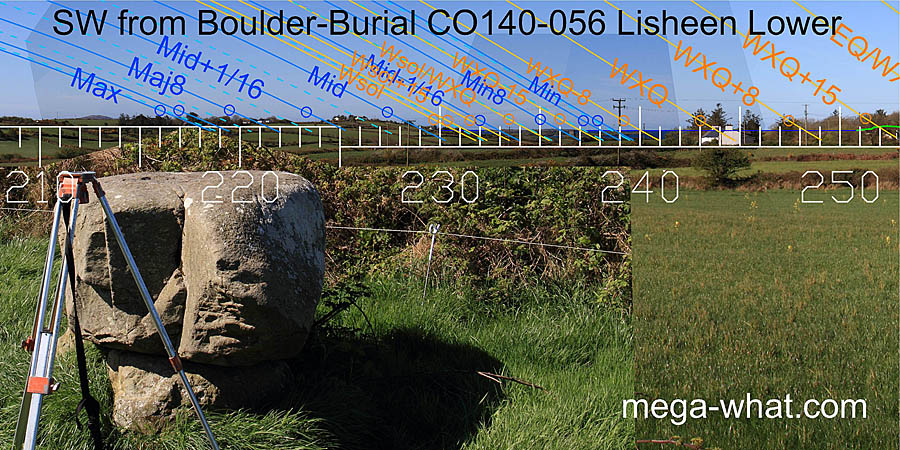 Lisheen Boulder-Burial
Lisheen Boulder-Burial:
This boulder has a long axis but the shape gives different angles. North-eastwards it centres on the minor standstill / cross-quarter. To the south-west it indicates the major standstill.
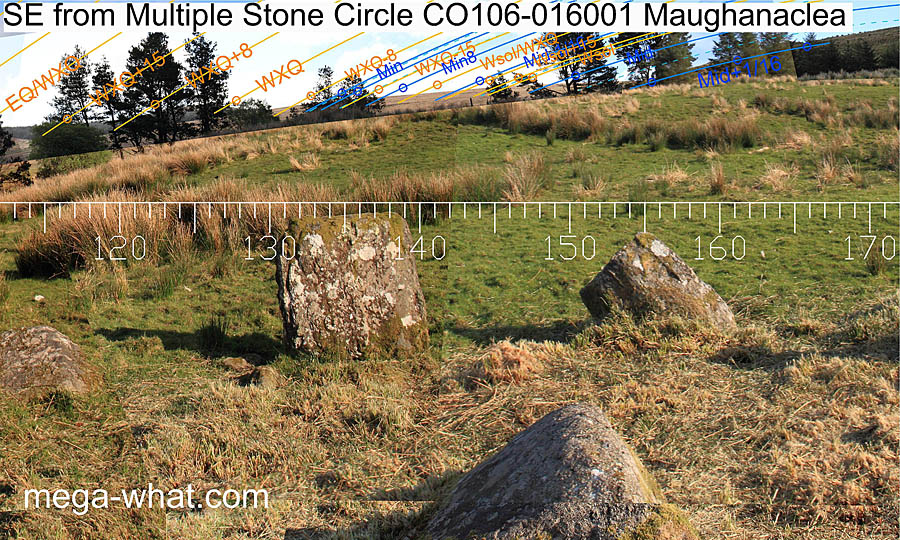
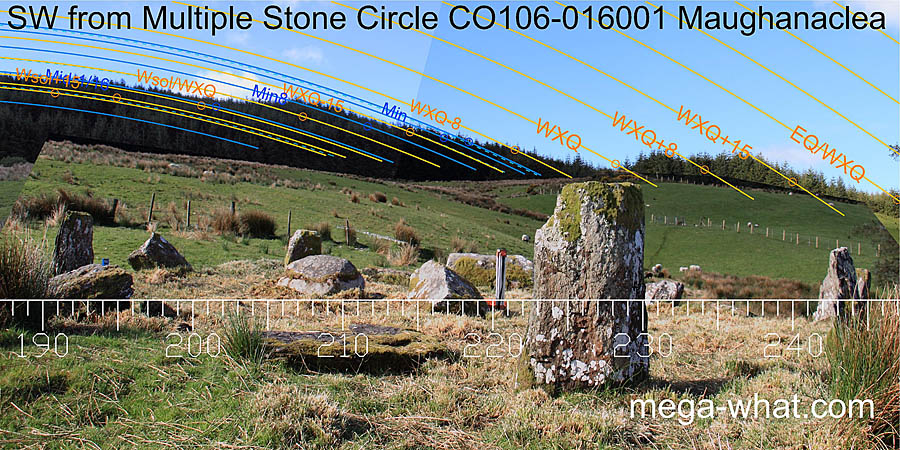 Maughanaclea Boulder-Burials
Maughanaclea Boulder-Burials:
Two boulder-burials lie within a stone circle. The central one indicates the minor side of the south-west lunistice zone.
The other, in the south-east quadrant of the circle, points to the major side of the south-east one.

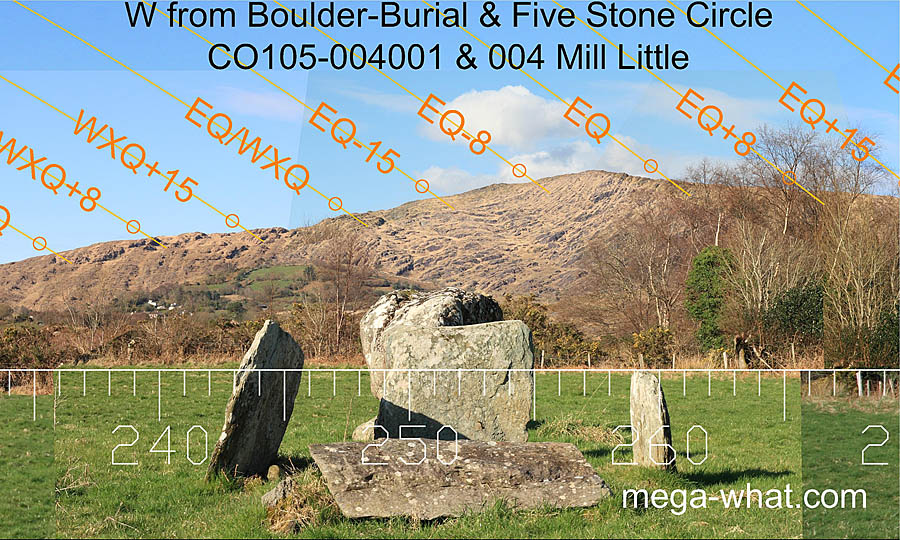 Mill Little N Boulder-Burial & Stone Circle
Mill Little N Boulder-Burial & Stone Circle:
Both boulder-burial and five stone circle indicate summer cross-quarters to the north-east.
To the west they point a week or two south of the equinox (before the spring one).
The circle's radially set portals are both broken stumps and the slab across them is field clearance.

 Oldcourt Boulder-Burial
Oldcourt Boulder-Burial:
The primary boulder is displaced. Beside it is another stone, recorded as a possible fallen standing stone.
This stone clearly indicates equinox sun rises and its reverse axis to the west is close to the equinox / cross quarter midpoint.
Almost certainly a secondary boulder-burial as at
Cooradarrigan.
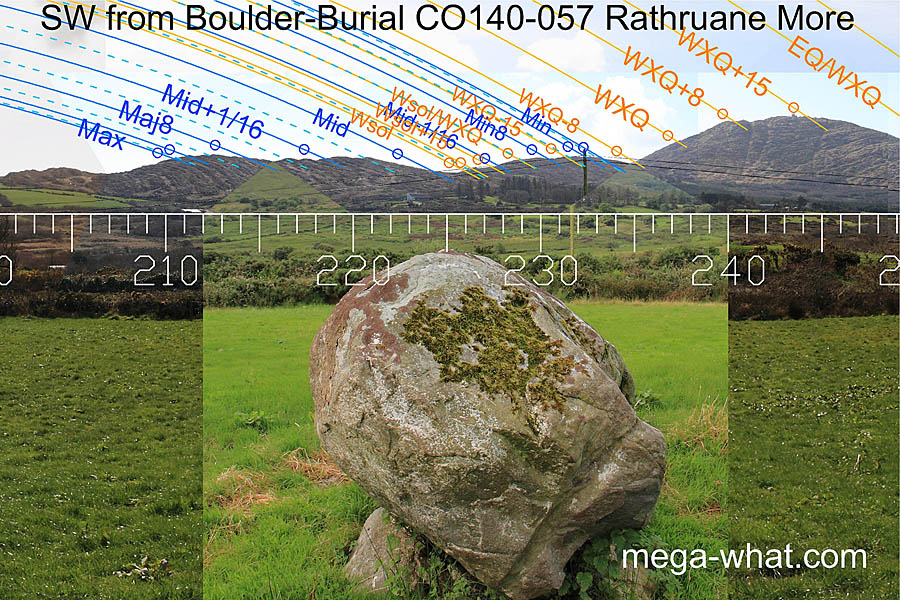
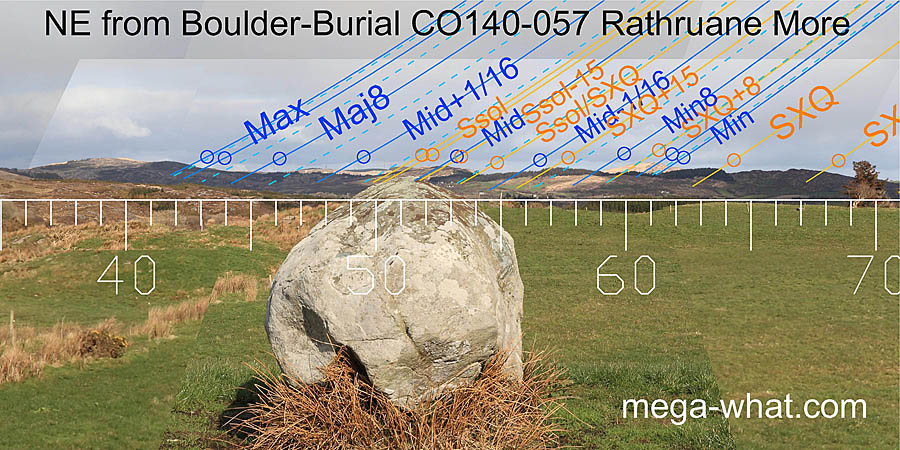 Rathruane Boulder-Burial
Rathruane Boulder-Burial:
The precise south-western axis cannot be seen due to the slope of the ground but is not important anyway because of the prominent solstitial dip.
The primary axis is to the north-east where the ridge of the boulder indicates summer solstice sun rises at a not otherwise very obvious position within a more prominently marked lunistice range.
© Michael Wilson.









